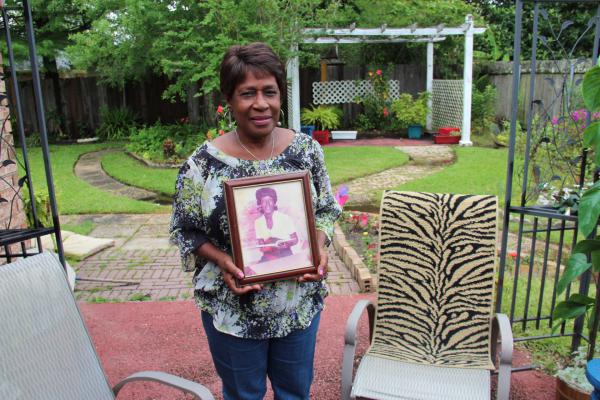
Margie Richard with a photo of her sister Naomi, who died at the age of 43. Richard suspected that emissions from Shell had something to do with making her sister sick. (Photo by Reid R. Fraiser / The Allegheny Front)
by Reid R. Frazier
The Allegheny Front
NORCO, La. — In June 2012, Pennsylvania officials flew to Louisiana to visit a couple of petrochemical plants owned by Shell, a company they were about to give big economic incentives to build a plant in Beaver County, Pa.
But they didn’t visit Margie Richard, who once lived in Norco, but now lives outside New Orleans.
If they had, they would have gotten another story about Shell’s operations here, a story about toxic emissions, industrial accidents, and how a very determined school teacher brought one of the largest companies in the world to the negotiating table.
Norco’s history is a window into the chemical industry’s sometimes rocky relationship with its host communities along the Mississippi River. And it may offer clues to how ‘fenceline’ communities near plants could manage their relationships with an industry that is expanding to take advantage of the natural gas boom.
At the center of Norco’s history stands Margie Richard, a retired school teacher, fervent Christian and gardener. Richard, a native of the town, helped lead a fight to get Shell to relocate families away from the plant, which the residents claimed was making people sick and posed a safety hazard. Richard’s quest, ultimately successful, was to get Shell to save the town by dismantling it.
Richard has a few words of advice for Pennsylvanians gauging what a large petrochemical plant could mean for their community.
“The local people need to come together and go to the table and tell them what they want. You should have input into what is going on,” she said. In Norco, she said, it took decades for the town to learn that lesson.
A tight relationship
Norco’s very name signifies the town’s deep relationship to Shell, its largest employer. In 1916, an affiliate of the company built a refinery—the New Orleans Refining Company, or NORCO. In the 1950s, looking to build a chemical plant near its refinery, Shell bought several blocks of farmland.
Richard’s grandfather owned one of those pieces of land, which he sold for $90. He then moved his family next to the plant, where Richard, now 71, grew up.
Diamond, the neighborhood where Richard, who is black, lived, was cut off from the white side of Norco, where many of the Shell workers lived.
The plant made methyl ethyl ketone, a solvent used in coatings, adhesives, and inks, among other things. Richard remembered growing up smelling the bleach-like odors from the plant.
“You smelled it—Lord have mercy—every day,” she said.
Richard was a young teacher in the town in 1973, when a 16-year-old named Leroy Jones was mowing the lawn of an elderly neighbor, Helen Washington. A spark from the lawnmower ignited gas from a leaking pipeline and Washington died in the blast.
Richard said she saw Jones coming down the street.
“He was trying to run to the other street, but his clothes were on fire,” she said. He later died of his injuries. The explosion galvanized Richard.
She noticed when her neighbors got sick or died of cancer, or when her children had breathing problems that sent them to the hospital. Her sister Naomi died at the age of 43.
Her concerns grew stronger after an explosion at Shell’s refinery in 1988. (The plant is now owned by Motiva, a joint-venture between Shell and Saudi Aramco, the Saudi national oil company). The explosion toppled a 16-story tower, and cracked walls and ceilings in houses and ceilings around Norco. It set off alarms 25 miles away in New Orleans.
“When that cat (catalytic) cracker went off, that fire was so huge. It was walking toward us,” Richard said. “And people were just runnin’ everywhere.”
